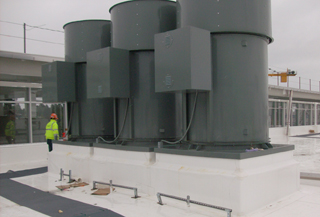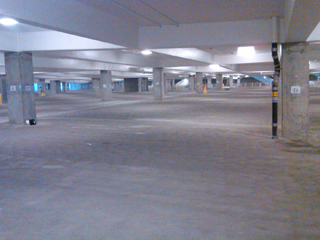|
Subscribe / Renew |
|
|
Contact Us |
|
| ► Subscribe to our Free Weekly Newsletter | |
| home | Welcome, sign in or click here to subscribe. | login |
Construction
| |
 |
April 19, 2012
MEP systems designed to fit big spaces
Harris Group

Nearly everyone is familiar with how big a football field is. To appreciate the sheer size of the Port of Seattle’s new Consolidated Rental Car Facility (RCF), imagine combining six football fields. This would approximate the footprint of this structure that will house the airport’s rental car operations.
The 2.1 million-square-foot RCF adjacent to Seattle-Tacoma International Airport will provide convenient, streamlined rental car access to the 45 million annual passengers anticipated to travel through the airport by 2025.
The rectangular structure is situated on a 23-acre site and consists of five levels, each about 400,000 square feet. Ready and return activities for the rental car operations will be accommodated on the operational floor plates of levels one through four. Two helices at the northeast and southeast corners will provide vehicular access to each level, which will also include an adjacent quick-turnaround area outside of the RCF footprint.
Each of the four quick-turnaround areas will have fueling positions, car washes, and support areas that will accommodate dispatch, minor workspace and employee restrooms. The Customer Service Building, consisting of storefronts for the rental car companies, will be located on the fifth level.
MEP design
As part of the RCF design team, Harris Group was responsible for the mechanical, electrical, plumbing and communication/information systems for this facility, with the exception of the quick-turnaround areas’ floor plate.
Harris’ design included medium- and low-voltage power distribution; emergency power generation; interior and exterior lighting and controls; power monitoring; operational floor plate ventilation; HVAC; a direct digital controls system; fire protection and alarm; plumbing; fiber-optic backbone; and multiple airport information systems that include telephone, Wi-Fi, cellular service and 800Mhz radio for emergency services personnel.
The considerable size of the facility presented complex challenges and innovative solutions for the design team. The vast operational floor plate required the design of each individual system to address inherent system losses and higher costs associated with long utility runs. To achieve this, Harris used a campus-style distribution system design combined with localized individual systems strategically placed on the roof and at the ends and centers of the floor plates.
Space allocations for utility systems were established early in the design and continuously managed with the development of each system to accommodate the port’s requirement for maximizing leasable space while maintaining the established building footprint. This required ongoing collaboration with the port and the numerous stakeholders, and constant reevaluation of individual system design for efficient use of non-leasable space for utility system equipment.
An example of this innovative design approach can be demonstrated with the operational floor plate exhaust and ventilation system. With the potential for a significant number of cars running at any one time in a covered structure of this magnitude, the hazardous buildup of carbon monoxide and air quality was a concern.
The typical solution for exhausting this type of facility is to provide a series of exhaust points across the operational floor plate and extend each one individually to the roof. However, this typical approach would have greatly impacted the flexibility of the operational floor plate and was quickly eliminated as a design solution.
Harris developed and presented multiple ventilation solutions to the team and port/stakeholders for their review and comment. As part of this design process, computational fluid dynamic analyses of several ventilation system designs were performed using iterative processes for different site-specific weather conditions and operational scenarios. One of the goals was to streamline and target the appropriate exhaust and ventilation requirements and locations to ensure an efficient yet cost-effective solution. This design solution achieved the required ventilation with no impact to the required operational flexibility of the floor plates.
Sustainability integration
Rental car processing facilities are not conventional LEED buildings. However, the port wisely saw the potential of this facility and designated it for its first ever U.S. Green Building Council LEED certification.
The design team participated extensively in the process of establishing the anticipated LEED credits through early-design charrettes and performing multiple life cycle cost analyses (LCCAs) for each potential design solution during the system selection phase. LCCAs were conducted for HVAC, medium-voltage distribution and floor plate lighting to minimize energy usage.
Efforts to meet the green initiatives entailed close collaboration with the entire team, including the port, members of the design team, outside sustainability experts and the contractor. The lighting and HVAC system designs both fully met the operational and energy code requirements, and qualified for a significant rebate from the Seattle City Light energy incentives program.
Collaboration is key
The rigorous focus on maximizing efficiency in utility space usage, managing inherent system losses and ensuring streamlined systems integration dictated a disciplined collaboration process among all project stakeholders, including the design team, numerous port division personnel and representatives from more than 10 rental car agencies. This coordination involved ongoing meetings, discussions, and major milestone presentations throughout the rental car facility’s nearly six-year span of design and construction.
The result of the collaboration and focus on sustainable design is an energy-efficient building that allows for a short payback period and significant cost savings. The project has been proclaimed the first LEED New Construction 2.2 silver rental car facility in the United States.
Scott D. Bergstrom, PE, LEED AP, is the project manager for the mechanical, electrical and communications design of the RCF out of Harris Group’s Seattle office. He is a senior project executive for the company. Harris is a Seattle-based multidiscipline engineering firm specializing in industrial manufacturing, process industries, life sciences, energy, and automation solutions.
Other Stories:
- The biggest building you may never use
- Rental car facility runs smoothly, with consultants’ help
- Moving sustainability forward at Sea-Tac Airport
- Structural design lends flexibility to rental car firms
- Art adds color to massive concrete structure
- Design drives rental car facility




